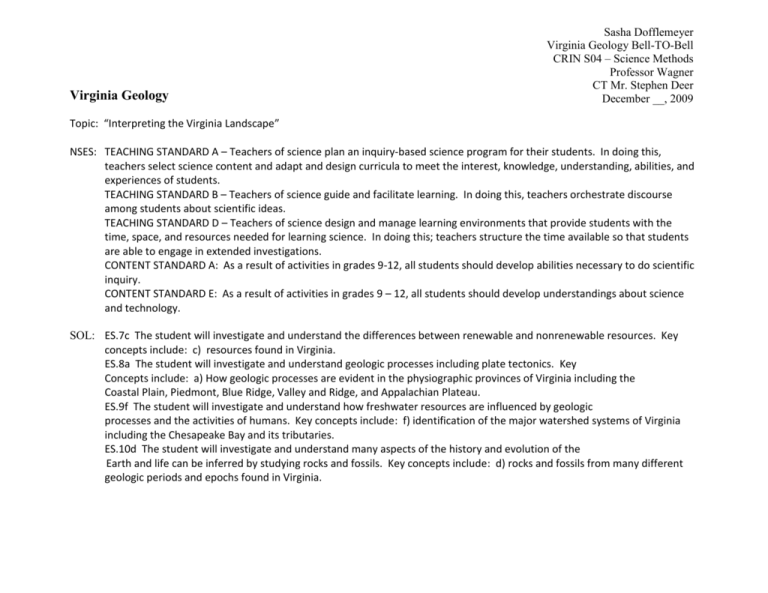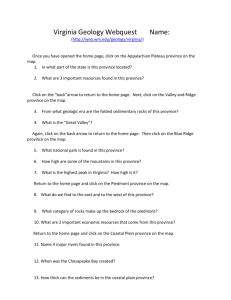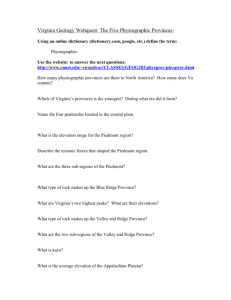1_Virginia Geology Lesson Plan
advertisement

Virginia Geology Sasha Dofflemeyer Virginia Geology Bell-TO-Bell CRIN S04 – Science Methods Professor Wagner CT Mr. Stephen Deer December __, 2009 Topic: “Interpreting the Virginia Landscape” NSES: TEACHING STANDARD A – Teachers of science plan an inquiry-based science program for their students. In doing this, teachers select science content and adapt and design curricula to meet the interest, knowledge, understanding, abilities, and experiences of students. TEACHING STANDARD B – Teachers of science guide and facilitate learning. In doing this, teachers orchestrate discourse among students about scientific ideas. TEACHING STANDARD D – Teachers of science design and manage learning environments that provide students with the time, space, and resources needed for learning science. In doing this; teachers structure the time available so that students are able to engage in extended investigations. CONTENT STANDARD A: As a result of activities in grades 9-12, all students should develop abilities necessary to do scientific inquiry. CONTENT STANDARD E: As a result of activities in grades 9 – 12, all students should develop understandings about science and technology. SOL: ES.7c The student will investigate and understand the differences between renewable and nonrenewable resources. Key concepts include: c) resources found in Virginia. ES.8a The student will investigate and understand geologic processes including plate tectonics. Key Concepts include: a) How geologic processes are evident in the physiographic provinces of Virginia including the Coastal Plain, Piedmont, Blue Ridge, Valley and Ridge, and Appalachian Plateau. ES.9f The student will investigate and understand how freshwater resources are influenced by geologic processes and the activities of humans. Key concepts include: f) identification of the major watershed systems of Virginia including the Chesapeake Bay and its tributaries. ES.10d The student will investigate and understand many aspects of the history and evolution of the Earth and life can be inferred by studying rocks and fossils. Key concepts include: d) rocks and fossils from many different geologic periods and epochs found in Virginia. Subject: Earth Science Grade Level: 9 Daily Question: Why does Virginia look the way it does? Procedures for Learning Experience Guiding Questions Engagement: The teacher will start with introducing the Geology of Virginia lesson rather simply. Introductory material includes: -reiteration of SOL standards covered by this lesson. -introduction to map of the Provinces of Virginia. (Note that this map is the image that the model will be based upon). -difference between the definition of a physiographic and geologic province. -descriptive characteristics of each province. What are the different parts of Virginia called? The students will have a guided notes page to complete along with the introductory lecture. How can we describe and place boundaries on these parts? Materials Needed -Teacher Computer Evaluation (Assessment) Informal evaluation, student participation. -PowerPoint -Projector Screen -guided notes from Lab Packet -create answer key Formal formative evaluation, guided notes in lab packet in which students will answer. Approximate Time Needed 15 minutes Exploration: In the previous section, the teacher discussed with the class some of the basic descriptors of the provinces. Now, the class is going to go into further detail. First, the class is going to create clay models featuring the physiographic and geologic provinces. Students will work in groups of 4; their group will be determined by the color of tootsie pop they receive. Because there are more than 4 tasks to complete, the students will have to divide labor. An example of how the students may divide labor includes: -student 1: cutting out provinces, making clay province 1, making clay province 5, gluing rocks for clay provinces 1 & 5 -student 2: cutting out labels, making clay province 2, making clay province 6, gluing rocks for clay provinces 2 & 6 -student 3: organizing rocks, making clay province 3, gluing rocks for clay province 3, gluing labels onto clay pieces and cardboard -student 4: organizing supplies such as cardboard, glue, scissors, and rock map guide making clay province 4, arranging provinces on the cardboard, gluing rocks for clay province 4 **Once students have the clay pieces arranged properly on the cardboard, they What are the rocks that are found in the different provinces? Why are they there? What does this tell us about Virginia’s Geologic History? -colored tootsie pops -Bags of Rocks Cardboard platform -blown up maps of Virginia -Clay -paper clips -Computer -rock map guide -crossword puzzle Informal evaluation of student participation in group work. Formal evaluation of student worksheets. Formal summative evaluation of clay model and individual and group participation. 40 minutes are to determine which rocks get placed where on the model. The students may use the rock map as a guide. Some of the rocks that may be found in the different provinces include: -Montmorillonite, -Arch Marble, -Feldspar, Gravel, -Granite, -Illmenite, -Catoctin, Vermiculite Concentrate, -Amphibolite, Zircon, -Limestone, -Diabase, -Staurolite, -Kyanite. If a group should finish before others, they may work on the crossword puzzle in the lab packet. Explanation: A PowerPoint presentation on the history of Virginia Geology and past Geologic events that have occurred will serve as the explanation for why Virginia looks the way it does. It will be inclusive of diagrams, definitions, timeline, and discussions of changes Virginia has made throughout geologic history. The powerpoint is designed to include class discussion. Extension: The extension an opportunity for the students to put together all of the knowledge they have just learned. In order to culminate and extend the lesson, the Why does Virginia have the geological features it has? What events have shaped the state of Virginia? Computer Wireless mouse (with laser pointer) Informal evaluation of student participation 7-10 minutes Informal evaluation of student participation. 15 minutes *collision/rift Powerpoint In what order did Virginia’s major geological events occur? Construction Puzzle pieces Why does Virginia look the Formal evaluation students will create a timeline that includes all of the major geologic events in Virginia’s history. The students will be given pieces to the timeline, which they must recreate by gluing the pieces onto construction paper. way it does? Yarn of student lab summary. Hole puncher The students will also have to complete a 1page lab summary, describing what they have learned in lab. The summary will include a certain number of vocabulary words that they must include. Connectivity: Virginia Geology is an extension of the unit on Plate Tectonics. It is not only fulfilling SOL requirements, but is important for the students to learn about the surrounding, natural environment. Safety: Students will be reminded of the following safety rules specific to this laboratory: -NO HORSEPLAY -Always hand someone scissors by pointing the handle toward them. -No running with scissors in hand. -laboratory materials are solely to be used for the purpose described in the lab. Any misuse of laboratory materials may result In disciplinary action, depending on the degree of the offense. Assessment: Formative and summative, informal and formal assessments are listed in the lesson plan. Differentiation Strategy: ALTERNATIVE ASSESSMENT -A hands-on, creative project like building a clay model is a nice alternative and break from the usual classroom curriculum. The students develop the skill of making clay models, which is a highly capable educative tool. Reports have shown that students who build clay models to help them remember materials usually get an A on the assessment for which they used this study strategy.








